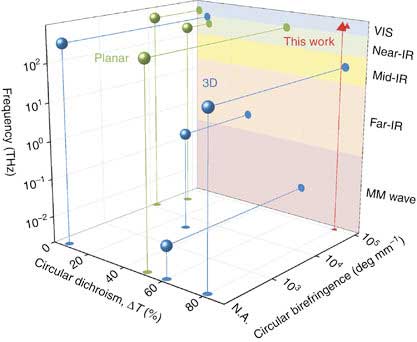| Posted: Feb 23, 2018 |
Giant intrinsic chirality from planar dielectric nanostructures
(Nanowerk News) Harvard researchers have developed a metasurface, comprised of a single planar layer of nanostructures, which exhibits strong optical chirality in transmission (Light: Science and Applications, "Giant intrinsic chiro-optical activity in planar dielectric nanostructures"). This means it can let circularly polarized light of one polarization pass through almost unhindered, while light of the opposite helicity is completely diffracted away.
|
|
Such capabilities are incredibly useful for a host of applications, such as circular dichroism spectroscopy in the analysis of drug samples, and polarization filters in telecommunications.
|
 |
| Typical chiral metamaterials. Representative examples of chiral metamaterials of varying designs and their measured performances at their respective operating frequencies. The performances are characterized by their circular dichroism (unnormalized, calculated from the differential transmittance ΔT) and circular birefringence, where applicable. Different colors correspond to different geometries of the chiral structures, that is, 3D (blue) and planar (green). Generally, the former possess significantly stronger chiro-optical effects due to intrinsic chirality. The experimental results from this work using planar structures that exhibit intrinsic chirality are represented by the red triangle. (© NPG)
|
|
This work challenges some long-held notions about chiral metamaterials and metasurfaces. "Previously people thought that to achieve a strong, intrinsic chiro-optical response, the structures had to be complicated three-dimensional shapes, such as corkscrews or helices, in order to break the symmetry," says Prof. Federico Capasso, Robert L. Wallace Professor of Applied Physics and Vinton Hayes Senior Research Fellow in Electrical Engineering at Harvard University. "These 3D metamaterials were extremely difficult to fabricate on a large-scale. With this work, we showed that even a planar layer of dielectric nanostructures whose thickness is on the order of the incident wavelength can exhibit strong intrinsic chirality. This offers a practical way for such devices to be implemented in various applications as they can now be made in a single lithographic step."
|
|
The authors were able to achieve this using gammadion-shaped nanostructures made of a relatively high-index dielectric material: titanium oxide.
|
|
"This allows us to create planar structures with a strong in-plane magnetic moment, without resorting to a 3D geometry. By further optimizing the in-plane parameters of the gammadions, we can achieve the necessary coupling between the electric and magnetic moments to observe strong intrinsic chiro-optical activity," says Alexander Zhu, first author of the study.
|
|
The authors experimentally achieved up to 80% circular dichroism in transmission at green wavelengths, with more than 90% of light with the correct helicity being transmitted at normal incidence. This result is on par with the state-of-the-art 3D metamaterials and greatly exceeds planar counterparts under similar conditions.
|
|
Further analysis points to some rich physics underlying this phenomenon of giant intrinsic chirality in planar structures. The authors found that the optical response of the gammadion structures is dominated by higher-order multipoles, such as the toroidal quadrupole and magnetic octupole. In naturally occurring media, such high orders are vanishingly small, such that only dipole responses are typically observed.
|
|
However, their existence is critical since dipole modes radiate primarily along normal incidence, whereas the primary radiation direction for higher-order modes is off-normal. This provides some insight into the design and optimization of these nanostructures.
|
|
The authors are now seeking to further improve these results and develop a fast, efficient sensor for spectroscopic detection of chiral compounds.
|

